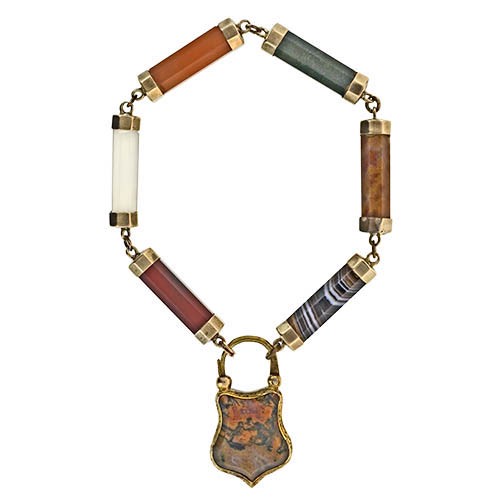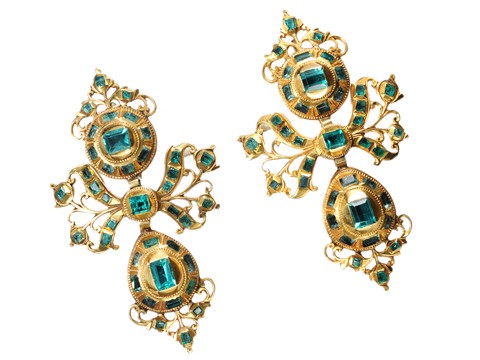The Week in Estate Jewelry: Tortoiseshell and the Holy Grail of Diamonds

You’re looking at a Golconda diamond, the holy grail of the diamond world. Golconda diamonds are the finest there is, with levels of purity and transparency unmatched by any other diamonds. Originally mined in the 18th century kingdom of Golconda, India, they are incredibly scarce. This one is particularly devastating — first off, it’s 5.06 carats, Asscher-cut, and set by Harry Winston. It’s also internally flawless, D-color, and certified by the Gemological Institute of America as a Type IIa, which means there’s no trace of nitrogen in the stone. (Nitrogen is the element that gives diamonds color.) The lack of nitrogen is the characteristic that sets Golconda diamonds apart, and means they are naturally whiter than those mined anywhere else.
I’ve only ever seen one in person, at an antique show in Miami Beach. A dealer friend beckoned me into his booth, whispering that he had something to show me. His salespeople formed a subtle wall in front of us as he went to his safe and brought out a ring box, which he slowly opened for me, his face full of joy. “It’s a Golconda…” he breathed. Now, I’m not a big diamond person, but that thing was NUTS. It lit up the whole booth! Sadly, the dealer wouldn’t even let me try it on, and the ring quickly went back into the safe to wait for its new (and phenomenally wealthy) owner.

This pendant/brooch is almost 375 years old! It’s Flemish, circa 1640. A turquoise- and white-enameled double bow curls in toward a floral centerpiece, with further enamel detailing in black and red. Emeralds and rubies are liberally sprinkled throughout the loops, flower, and leaves. It’s amazing that a pendant this delicate and lovely has remained intact over the centuries. It looks like an emerald is missing from the bottom left loop, but really, who cares? Pieces like this remind me to take care of the things I cherish, because they’ll last a lot longer than I will.

In 1852, Queen Victoria and Prince Albert bought Balmoral Castle in Scotland. They promptly demolished the place (too small!) and built the current castle, which Victoria referred to in her journal as her “paradise in the Highlands.” Albert designed a Balmoral tartan pattern, and the two delighted in dressing their kids up in full Scottish (Scots? I never know) regalia. All this enthusiasm inevitably sparked a public trend for everything Scottish, and agate — a beautiful, variegated earth-toned stone native to Scotland — was featured in tons of jewelry designs of the time. Round or dagger-shaped brooches were the most popular form, but occasionally agate was used in other ways, as in this bracelet. Each link consists of an octagonal-cut agate capped in 9k yellow gold, and a shield-shaped agate lock forms the clasp. Most Victorian agate jewelry was set in silver, so this piece is unusual.

Made circa 1820, these pretty Georgian tortoiseshell drop earrings feature a floral bouquet in an oval plaque and lacy openwork frame, suspended from an arrow-capped bar and a circular plaque. It’s a testament to the durability of tortoiseshell (which has been banned from trade since the 1970s) that they have survived without damage.

This ring features a famous anti-slavery motif in intaglio form. Made circa 1820 (the gold setting dates to later), the intaglio shows a kneeling slave raising his manacled hands in supplication, while around the border sits the motto: “Am I not a man and a brother?” The ring is in excellent condition and the intaglio stone itself looks like it might be carnelian. This particular image was chosen as the emblem of the Quaker Society for Effecting the Abolition of the Slave Trade in 1787. It was also widely reproduced in medallion form by the dedicated abolitionist Josiah Wedgwood. Using his distinctive jasperware pottery, Wedgewood placed the male figure in black on a white or cream-colored background, and the resulting medallions were used as brooches, hat pins, or other ornaments. Wedgwood also sent a gift of the medallions to Benjamin Franklin in Philadelphia, and Franklin promptly responded,
I am distributing your valuable present of cameos among my friends in whose countenances I have seen such marks of being affected by contemplating the figure of the Suppliant, which is admirably executed, that I am persuaded it may have an effect equal to that of the best written pamphlet in procuring favour to those oppressed people.

An early Jensen pendant, from 1920 or so. Georg Jensen was one of the most famous designers to come out of Scandinavia. Born just outside of Copenhagen in 1866, Jensen initially started out as a sculptor and ceramicist — two pursuits that unfortunately didn’t earn him much of a living. He then turned to silversmithing and jewelry design, and opened his first shop in Copenhagen in 1904. His style combines elements of both the Art Nouveau and the Arts and Crafts movements that were popular at the time. In his designs, the sensual, sinuous plant and animal motifs of Art Nouveau — known in Denmark as skønvirke — were joined with the Arts and Crafts philosophy, which declared that good, handcrafted design should be accessible to all levels of society. Jensen accomplished this by pairing exceptional metalwork with reasonably priced semiprecious stones — as in the case of this pendant, which features a gorgeous blue labradorite. The Jensen company continues to thrive today, and celebrated its centenary in 2004 with a big exhibit at the Statens Museum for Kunst in Copenhagen.

This retro bracelet is just really, really pretty. It’s 18k yellow gold, with cultured pearls and 2.80 carats of round cut sapphires. It dates to the 1960s.

Here, by special commentor request!, we have a camphor glass pendant, made circa 1920. Crafted in 14k white gold, this Art Deco piece features camphor glass, a milky white glass that was made by factories in the US Midwest in the mid-19th century. Camphor glass was either blown or pressed, and its trademark cloudy finish was achieved by exposing the glass to hydrofluoric acid vapors. It was meant to resemble rock crystal, another popular material used in jewelry of this period and type. (Rock crystal is actually colorless quartz, a naturally occurring material.) Camphor glass was also used to make vases, candlesticks, dishes, and other types of decorative items. This particular pendant is a good example of the most popular type of camphor glass jewelry. A rectangular glass plaque is set in a delicate frame with a central embellishment; the back of the glass is cut into a starburst pattern, which shows through the front of the piece and highlights the center detailing of enamel bars and a round-cut diamond. Camphor glass is most often seen in this milky white shade, but I’ve read that the Sandwich Glass Company of Massachusetts also made it in blue.
A side note: this piece is marked “DIANA,” which is a subsidiary of Krementz & Company of Newark, New Jersey. Both Krementz and Newark have a very important part in the history of American jewelry… I’ll tell you about it sometime in the future!

These earrings are from 1780 or so, and come from Spain or Portugal — opulent, cascading designs are a key feature of antique jewelry from the Iberian Peninsula. Each earring showcases 27 table-cut Colombian emeralds set in 15k gold, with an overall ornate yet symmetrical design. Subtle, right? WOW.

Attention! More cool jewelry coding!
This style of pendant is called a lavalier; it’s supposedly named after a mistress of King Louis XIV and usually features one or more gemstones in a long drop of delicate metalwork. This particular piece is Edwardian (1901–1910), with peridot, seed pearls, and amethyst set in 9k gold. That’s not the only reason it’s interesting, though. Back in 1903, English suffragette Emmeline Pethick-Lawrence proposed the use of colors to represent the women’s suffrage movement. She chose three colors to symbolize the ideals of the cause: green for hope, white for purity, and violet for dignity. Put the first letters of the colors together, and you also have an acronym for “Give Women the Vote.” The colors proved popular, and women in both England and America began using them in sashes, clothing, and, yes, jewelry. By wearing the jewelry, a woman could signal her views to fellow suffragists, and at the same time shield them from a possibly antagonistic husband. It’s pretty brilliant marketing.
The style of suffragette jewelry is no different from the general Art Nouveau/Arts & Crafts style of the time; the importance lies in the colors. Stones like amethyst, peridot, moonstone, and pearls were used, as well as enamel. Other jewelry was brought into the cause, too: Chain link bar brooches were worn to signify oppression, and brooches in the shape of prison gates were awarded to women on both sides of the Atlantic who were jailed (and some of them horribly abused, particularly in England) in their pursuit of the vote. HOWEVER, none of this means that we know for sure that this particular pendant was once owned or worn by a suffragette. But it’s still a helluva story. There’s a massive collector’s market out there for suffragette-colored jewelry, and that has driven prices out the wazoo. If you find a quality piece from a reputable dealer, move fast and expect to pay!
Previously: Secret Messages, Butterflies, and Bat Wings.
Monica McLaughlin needs to marry well, because she’ll never be able to afford any of this stuff on a publishing salary.